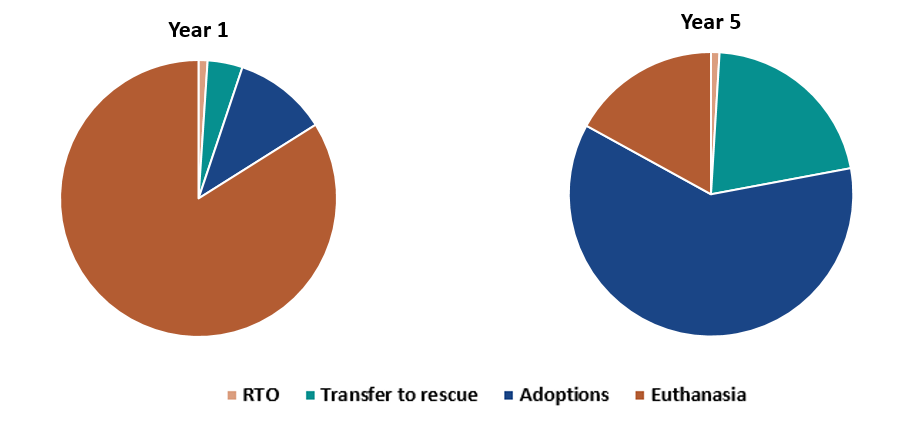Module 6: The Case of the Overwhelmed Shelter
Using Data to Analyze Trends in Shelter Outcomes
The life-saving capacity of a shelter is measured by the number of animals that leave the shelter alive through lost pets returned to owner (RTO), transfer to a pet placement partner (rescue group or another shelter), or adoption into a home. Stagnation or advances in life-saving are best recognized by analyzing trends in outcomes and live release over time. These trends can identify outcomes that have increased live release and those that need bolstering for further increases.
Live release is expressed as a rate where the number of animals released alive are expressed as a proportion of those admitted to the shelter during a period of time.
Live Release = RTO + Transfer + Adoption
Live Release Rate (LRR) = Live Release/Intake X 100
Let’s return to the large Florida municipal shelter. The table below contains the outcomes for cats for the past 5 years and the LRR.
| CATS | Year 1 | Year 2 | Year 3 | Year 4 | Year 5 |
| Intake | 18,110 | 14,656 | 12,120 | 10,695 | 10,425 |
| RTO | 191 | 147 | 113 | 106 | 100 |
| Transfer to rescue | 740 | 1,107 | 1,733 | 1,818 | 2,200 |
| Adoptions | 1,977 | 2,132 | 2,555 | 4,697 | 6,353 |
| Euthanasia | 15,202 | 11,270 | 7,719 | 4,074 | 1,772 |
| Live Release | 2,908 | 3,386 | 4,401 | 6,621 | 8,653 |
| Live Release Rate | 16% | 23% | 36% | 62% | 83% |
In Year 3, the shelter implemented new adoption policies that included fewer restrictions for adoption and adoption fee waivers. The shelter also waived transfer fees for rescue groups and performed spay/neuter surgery and vaccination for cats selected by the rescue groups.
The graphs below compare the feline outcomes in Year 1 to those in Year 5.

Test Your Knowledge
The intake data showed that the largest source of feline intake for this shelter over the past 5 years is stray cats. The shelter vet determined that 70% of the cats euthanized in Year 3 were stray cats deemed unadoptable due to feral behavior. To increase the number of cats released alive, the shelter vet decided to start a return-to-field program where healthy stray adult cats without identification are spayed or neutered and vaccinated, then returned to the location where they were living and thriving. This community cat management strategy has revolutionized life-saving capacity for shelter cats, frequently changing the LRR from 10% to 90%.

